Purple dead nettle is a fantastic common weed that can be used as a nutritious vegetable and it has so many powerful medicinal benefits!
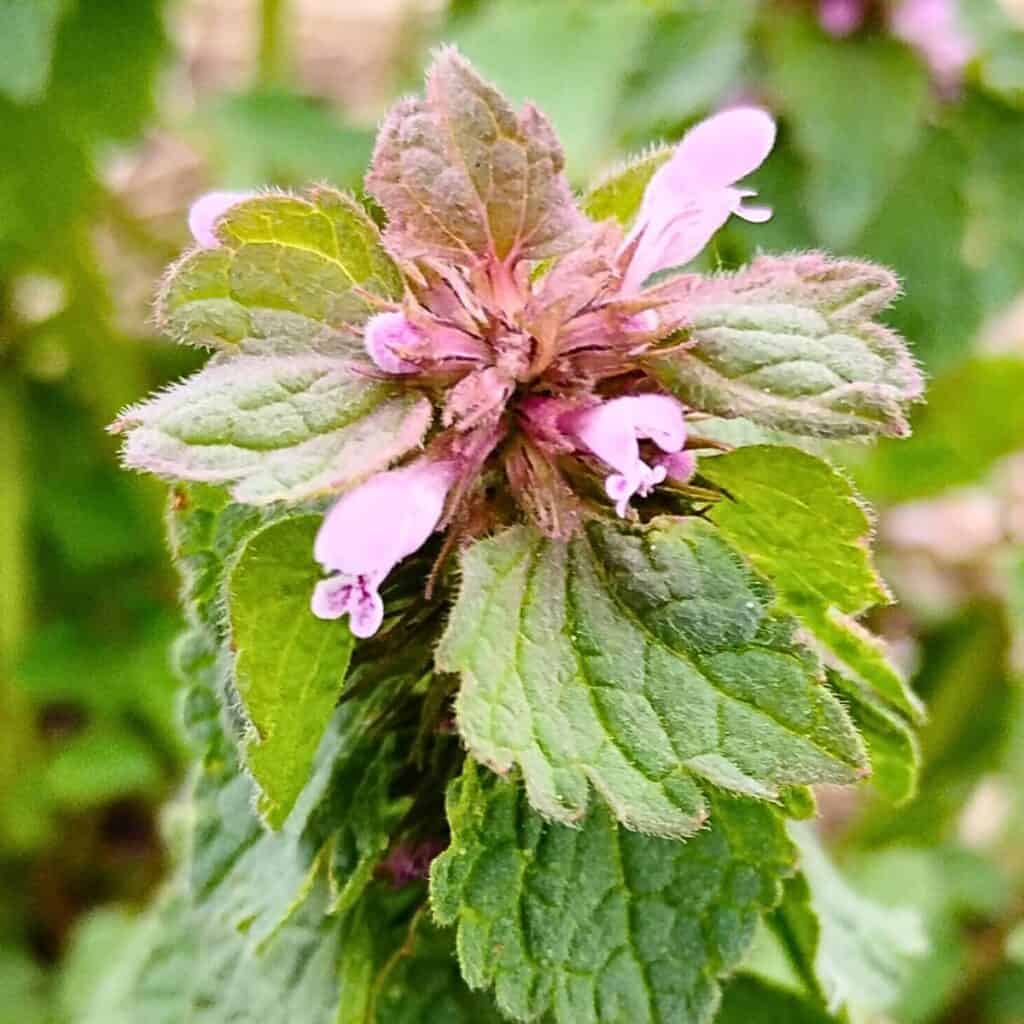
This post contains affiliate links. As an Amazon affiliate, I make a small commission at no extra cost to you if you make a qualifying purchase. See my full disclosure here.
As is common with so many “weeds”, purple dead nettle has fantastic nutritional value as a vegetable. It’s nutritional profile is comparable to, or better, than those cultivated greens that we plant in our gardens.
Foraging for wild herbs is a way to add more nutrition to our diets and many wild greens have fantastic flavor too. In addition, many, such as this purple dead nettle, appear long before any greens show up in our cultivated gardens. Here we’ll discuss the medicinal benefits and uses for purple dead nettle and how to preserve those benefits for healing purposes by making an easy tincture.
If you love wild greens and dead nettles, try making a Foraged Wild Weeds Pesto Recipe with dead nettles and other wild weeds.
Get To Know The Purple Dead Nettle
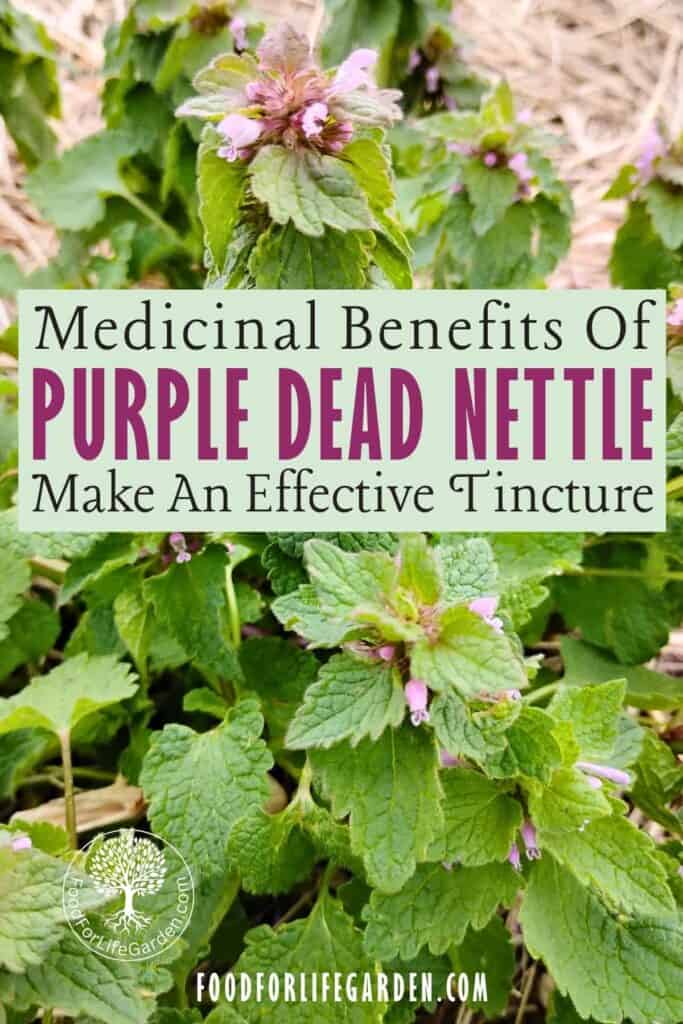
The purple dead nettle (Lamium purpureum) is part of the huge mint family (Lamiaceae). It’s folk name suggests that it looks like a stinging nettle, but its hairs do not sting. I don’t think it looks at all like a stinging nettle, but someone must have perceived it that way. Other names for it are purple archangel or red dead nettle.
The purple dead nettle is a native of North Africa, Europe and Siberia. While it’s cousin, the white dead nettle (this is the one I know from growing up in Germany) is a native of Asia and Europe. The purple dead nettles, apparently, are quite happy here in their new home in America. In fact so much that they are considered an invasive species in some places. I have not encountered the white dead nettle (Lamium album) here in the States yet.
Much of the scientific literature that discusses medicinal uses of lamiums focus around lamium album, the white dead nettle. There are a number of studies showing its benefits while information on the purple dead nettle is a bit more obscure. However, their medicinal constituents are quite similar and are listed for both species in several scientific papers.
In any case, historically both have been used in similar ways in traditional medicine. Since most of the active compounds are common among the two, they are likely to be beneficial in similar ways.
The Reason For This Article
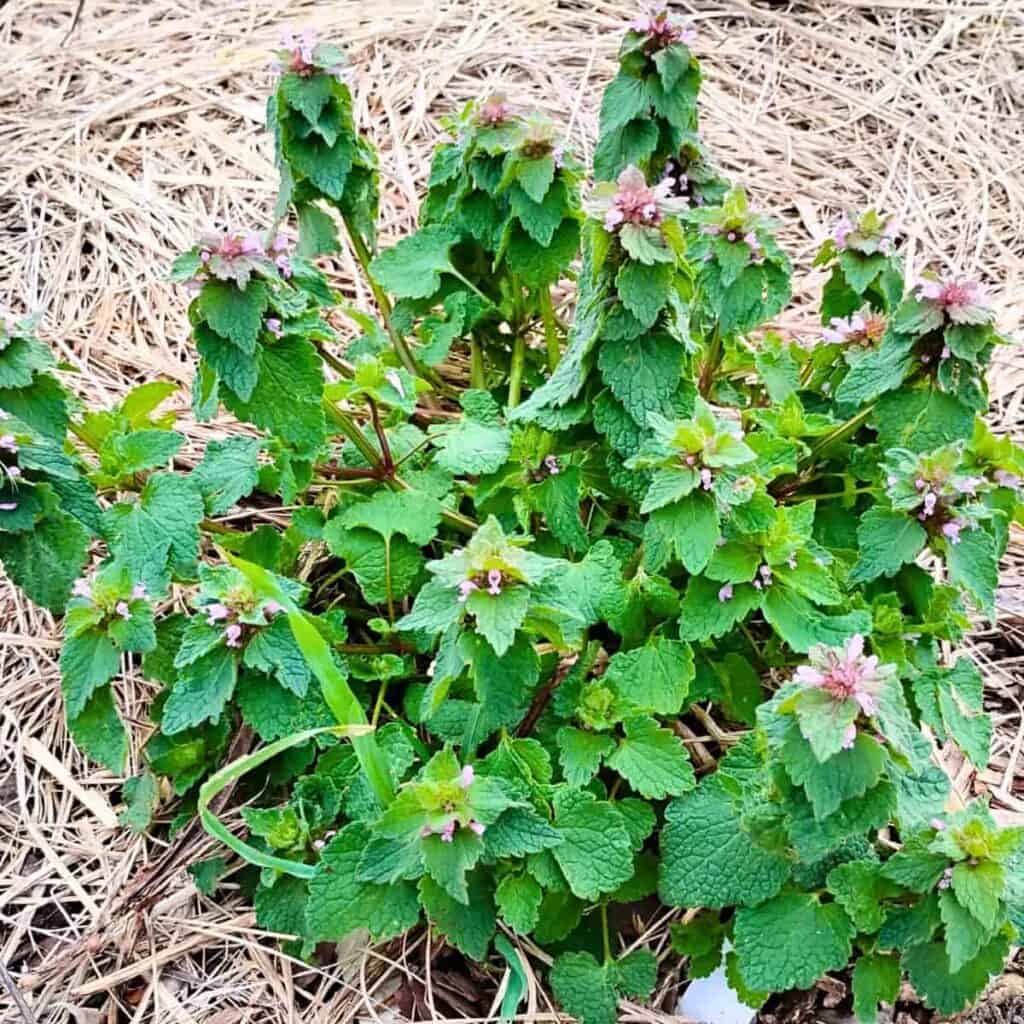
So, after putting in my garden last year, lo and behold I found a patch of purple dead nettles appear right beside the garlic bed first thing early this spring. How exciting! And this is what we’ll be talking about today.
While my little patch is not large enough to make a meal, I had enough there to make a nice tincture (recipe follows), and to make a tasty wild weed pesto (coming soon). And this summer, I’ll be helping this little purple dead nettle plant spread its seeds because I’d love to have more of this useful plant so I can eat and preserve it as a vegetable.
Update: While I was out picking my homegrown mushrooms yesterday, I found another small patch of the purple dead nettle in my newly planted food forest. Looks like they want to make my place their home and don’t need my help after all. Right on!
Here is why I love having edible weeds nearby. Where I live in Missouri, growing any kind of greens is super challenging. The pest pressure is extraordinarily heavy. Much worse than anywhere else I’ve gardened. Like, exponentially worse!
I had virtually no cabbage, kale, broccoli, chard, beets, or mustards. All of these are my favorite greens and they were devoured by millions of pests during my first year gardening here. Who told them that I was starting my garden?
But lots of weeds did just fine and so did a few unexpected greens like sweet potato leaves. Sometimes, if you want to survive off your land, you’ll have to learn to work around your enemy and take advantage of what grows well, even if it’s not your conventional or intentionally planted food.
Purple Dead Nettle Plant ID
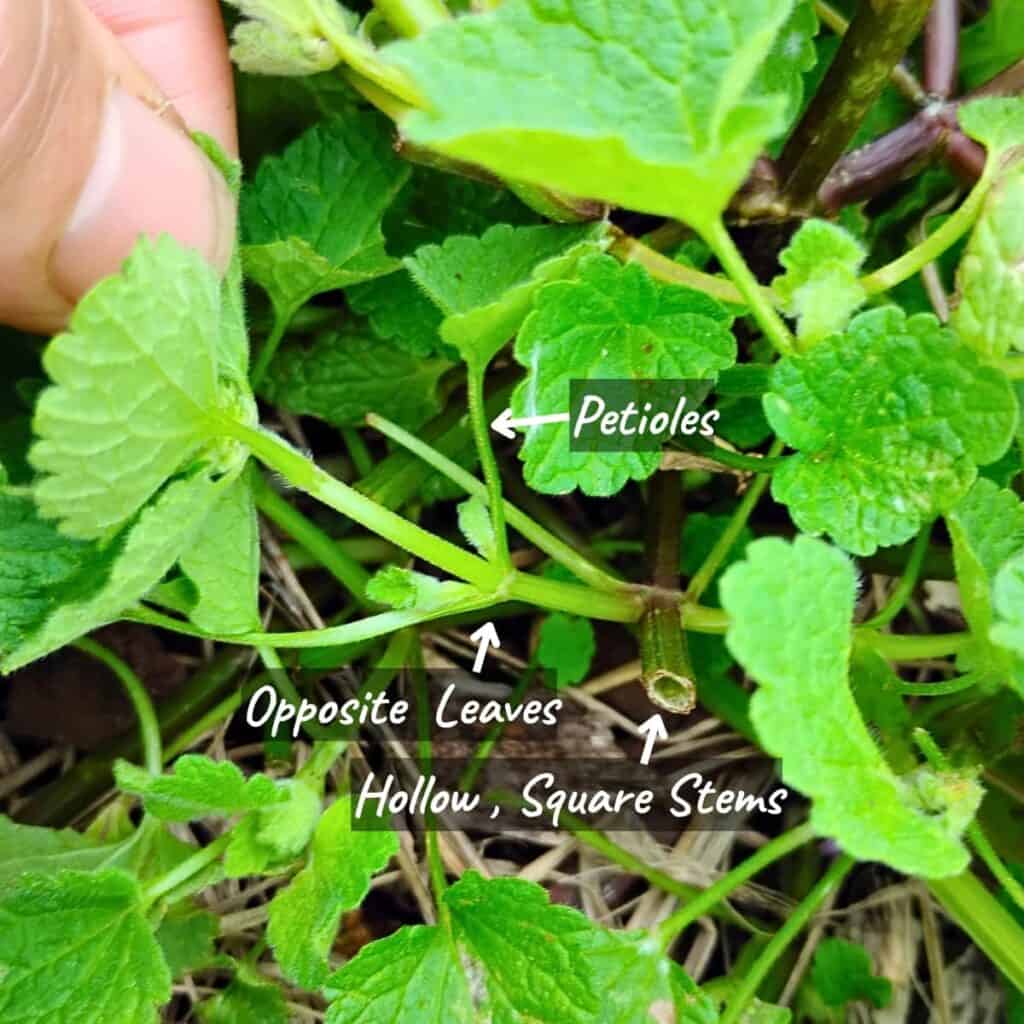
The stem of the purple dead nettle is square and hollow like is common for mint family plants. It often has a purplish hugh. Several stems grow from a single taproot.
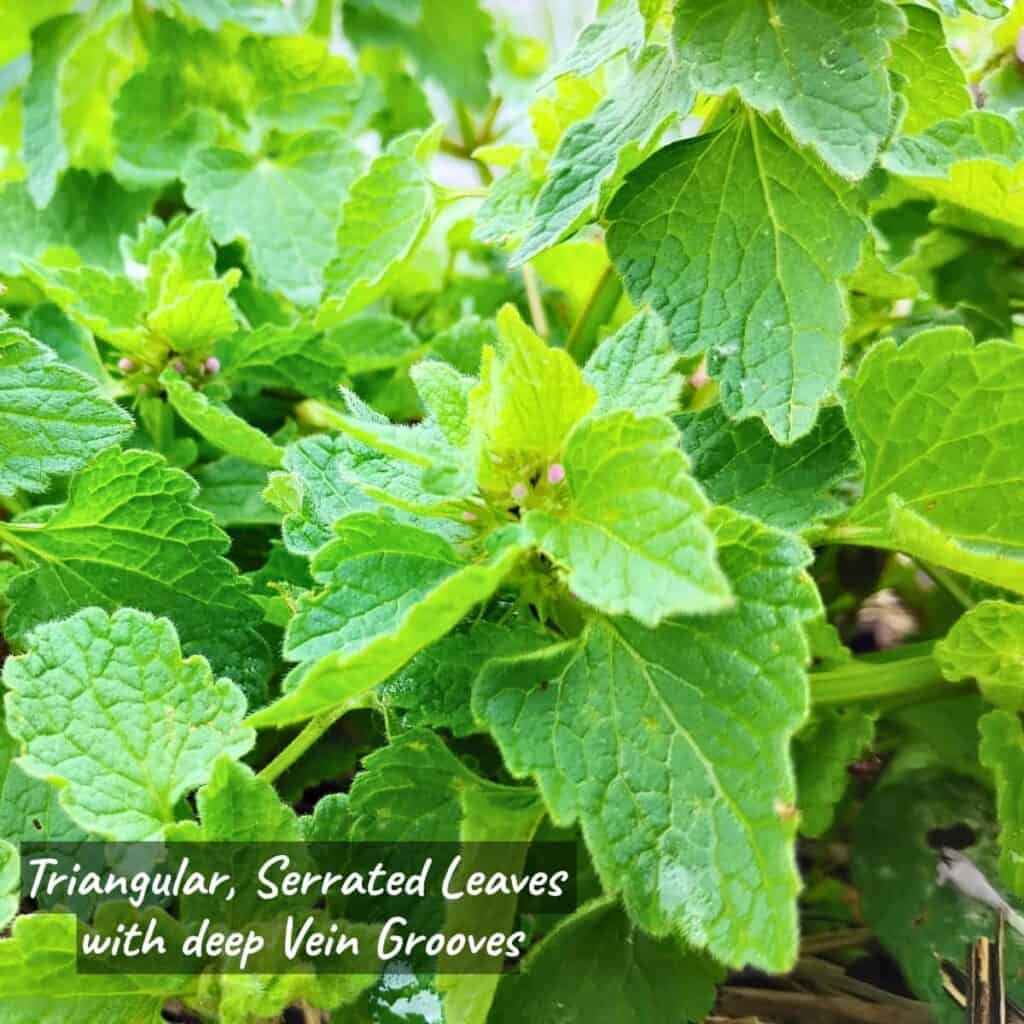
Leaves: The fuzzy leaves of the purple dead nettle have leaf-stems or petioles, which are arranged directly opposite of each other. They are longer near the bottom and grow shorter towards the top. However, at the very top they seem to attach directly to the stem without a petiole. The leaves normally tend to point downward. The shape of the leaves is triangular and they are gently serrated.
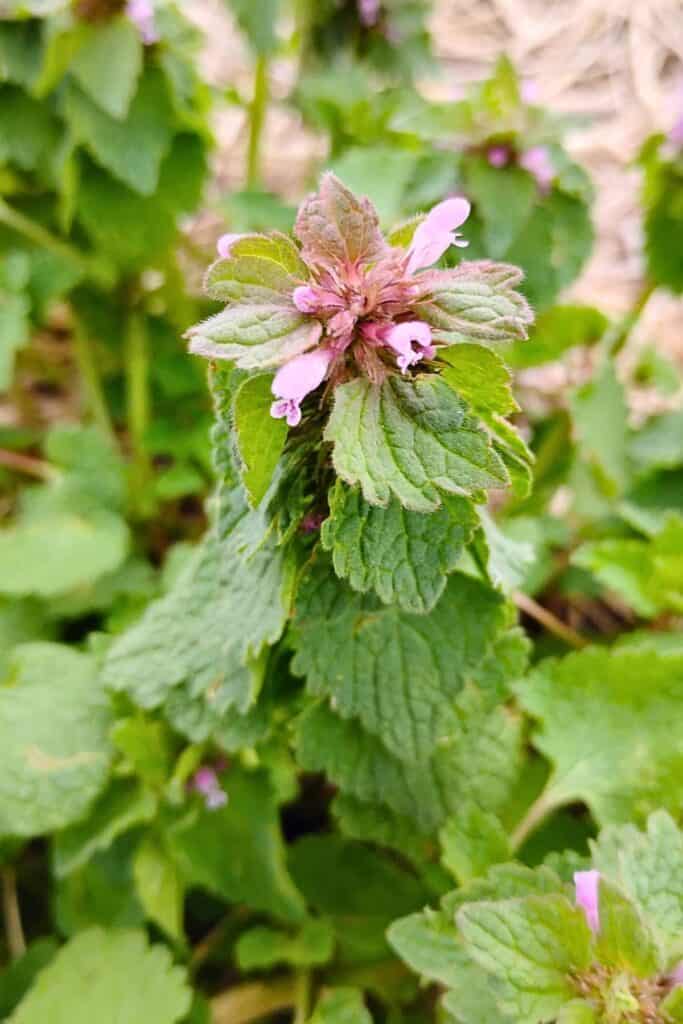
Flowers: There are whorls of 6-10 flowers that form between sets of leaves around the main stem. These flowers have two bottom lobes and a larger hood covering the flower. The flowers are pink to purple. They are technically 5 lobed flowers, but have been fused together to form a tube.
Growing Habit: The purple dead nettle is a winter annual. That means it germinates in the fall and starts growing flowers in the very early spring, sometimes even through the snow.
After flowering, it will set seeds, which are often dispersed by ants, which have a close association with dead nettles. This is the plant’s primary method of propagation. You’ll likely find more patches after an initial occurrence in the vicinity. And, you’ll likely see ants crawling all over the plants when you encounter dead nettles.
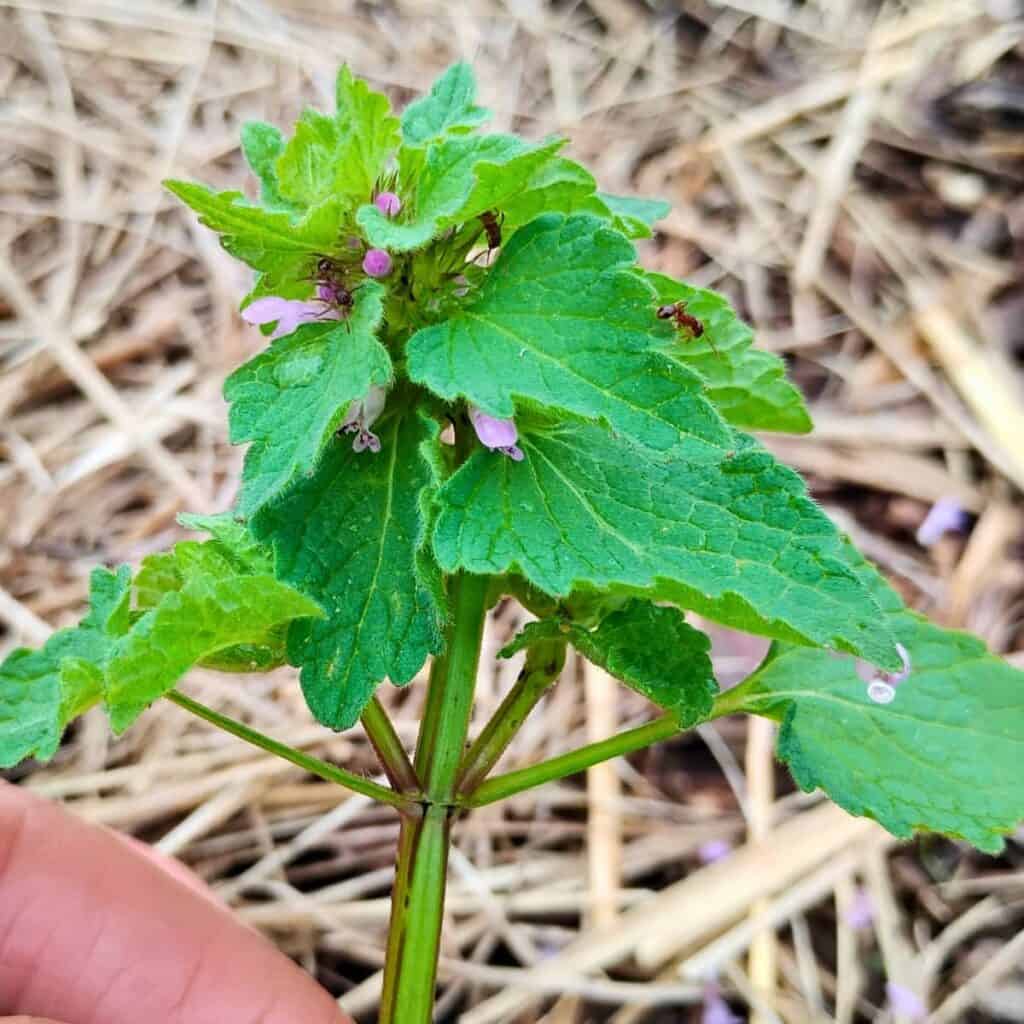
The seeds of both, purple and white dead nettles, have small, white, nutritious appendages that are called elaiosomes. This is a tasty and nutritious food for the ants, who gather the seeds to feed this substance to their larvae. And in this way, they are helping the dead nettle by dispersing its seeds.
After the purple dead nettle plant has gone to seed, it will eventually die. There are other dead nettle species that are perennial, such as the spotted dead nettle, which is often grown as a pretty ground cover in flower gardens.
Similar looking plants:
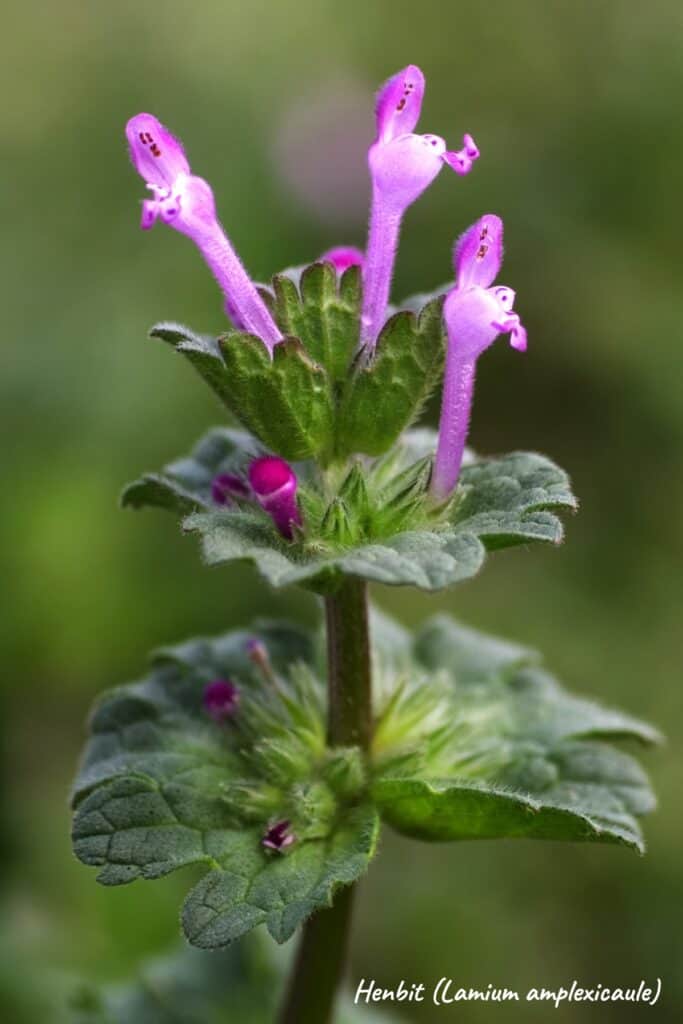
The Purple dead nettle is sometimes confused with Henbit (Lamium amplexicaule), a plant that often grows right beside the purple dead nettle. Henbit is of the lamium genus too and is also edible. The leaves of the henbit are sessile, they do not have stems. They are deeply lobed and are arranged across from each other on the stem. They point upward instead of down. And their flower tubes are generally longer than those of the dead nettle.
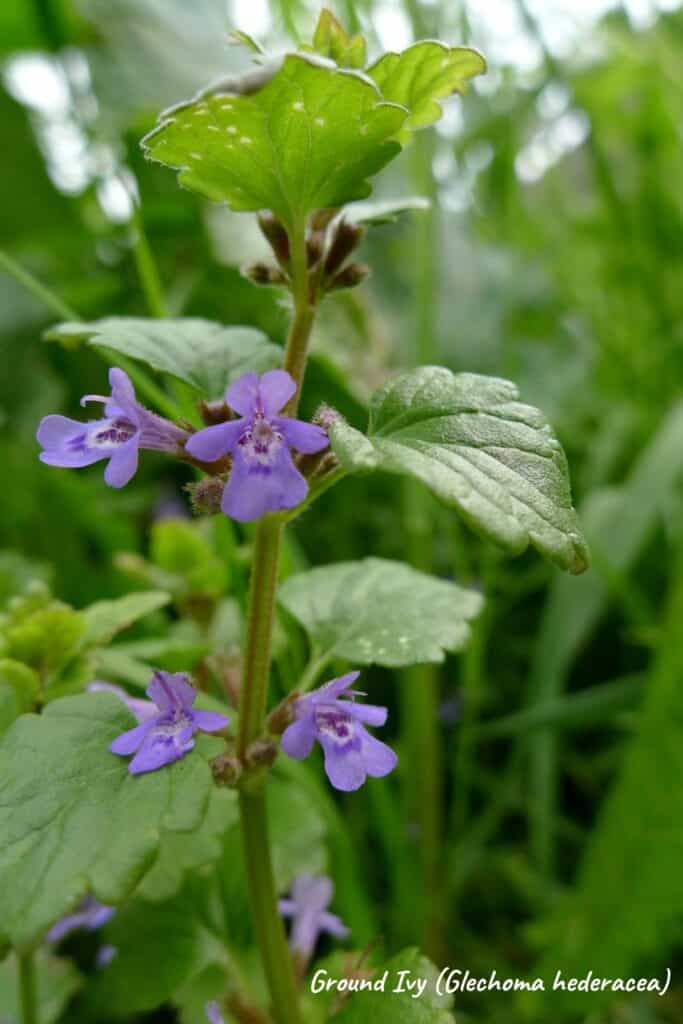
Ground Ivy, or chreeping charlie (Glechoma hederacea) has a bit of a similar appearance. It is an edible plant.
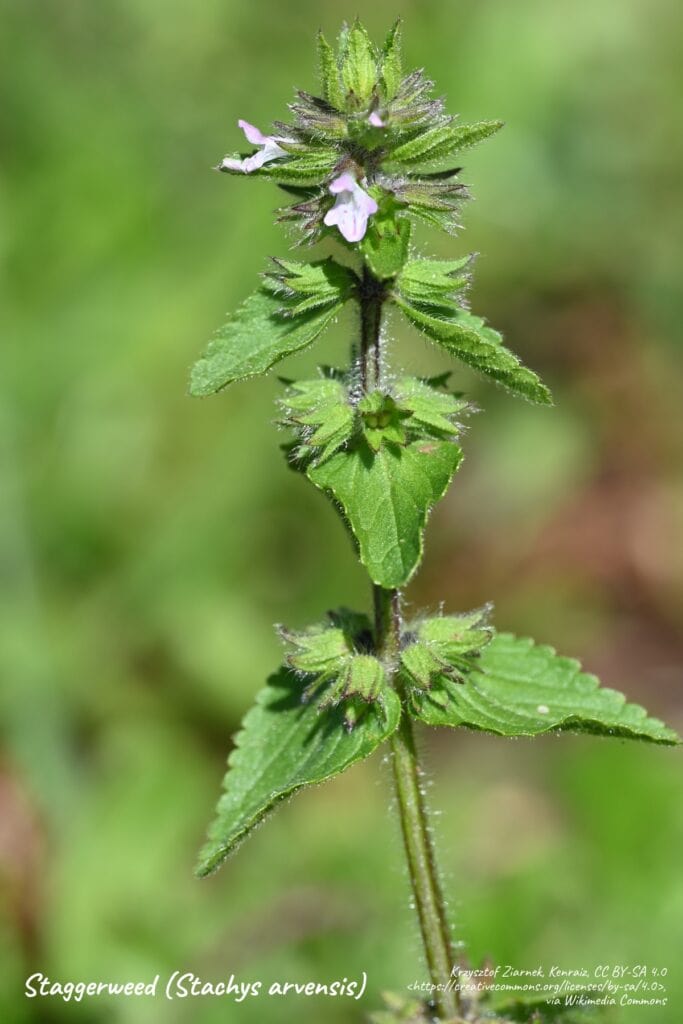
Staggerweed (Stachys arvensis) looks quite a bit like purple dead nettle, but has more oval shaped leaves and a more hairy stem. It’s stem is not hollow and its leaves are smaller than that of the purple dead nettle. Staggerweed is poisonous to livestock and not recommended for humans to eat.
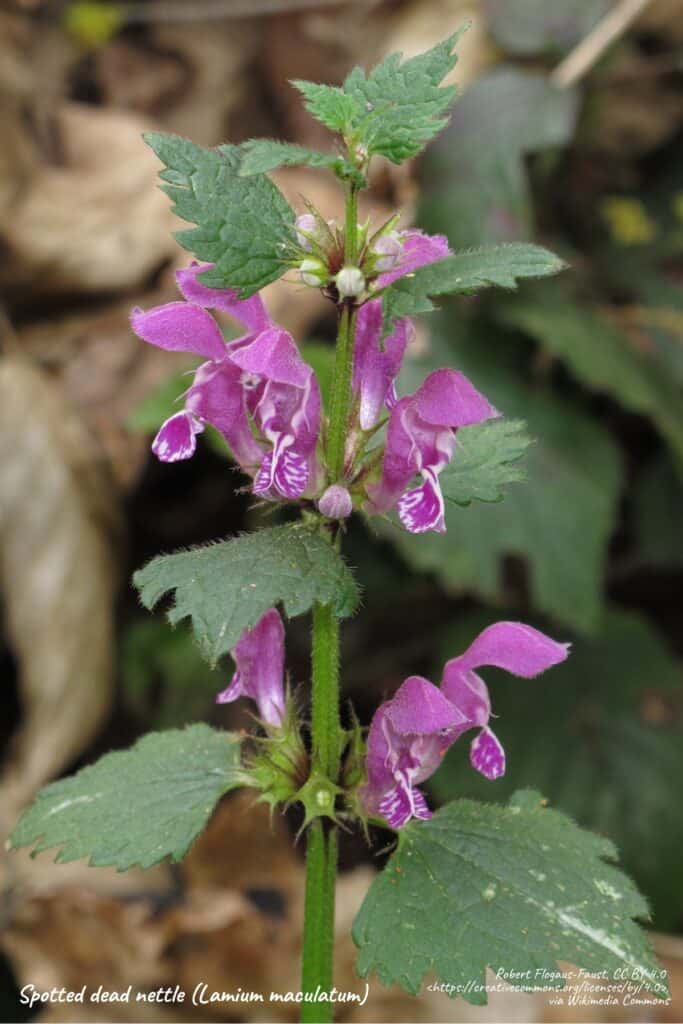
Another similar plant is the Spotted dead nettle (Lamium maculatum), which is usually cultivated in flower gardens and has variegated or spotted leaves.That one is not recommended for eating either.
Do not consume any wild plants without properly identifying them. Use a knowledgeable guide if possible, and at least two reputable sources of identification information. And as always, when introducing new foods and herbs to your diet, be cautious and start with small amounts in case of allergic reactions.
Another caution: Do not forage along roadsides, under power lines, or in other places where pesticides have been applied, which often includes lawns.
Great for bees and other pollinators
The purple dead nettle is an important pollinator plant. It flowers very early in spring when there are no other flowers available for pollinators such as bees. The flowers exude a pheromone that is attractive to pollinators and it can help them get through the early spring ‘hunger gap’.
Why wild herbs are Often highly nutritious
Through centuries of cultivation of green vegetables, generally the focus has been more on increasing size, ease of harvest (especially during this industrial farming age), maybe disease resistance, or other qualities. But it didn’t so much include nutrient density.
That said, it appears, focus seems to be shifting back to increasing nutritional value, as we can deduce from the introduction of many purple colored vegetable varieties in recent years.
However the plants that we find in the wild were not subject to these human selection preferences and for that reason, many of them have superior nutritional profiles when compared with our common garden greens.
In the wild, only strong and healthy plants will adapt and be able to continue the species. While Spinach is considered one of the garden ‘superfoods’, it is far surpassed in nutrient value by many ‘weeds’ like lambs quarters, sorrel, dandelion greens, and chickweed.
Where To Find Purple Dead Nettle
Purple dead nettles and other wild weeds often show up in disturbed soil and fields that have been tilled. They can be found in lawns, alongside roads and driveways, next to structures, and where fires had cleared wild areas. They are first on the scene opportunists, the pioneers that begin the natural progression of succession in nature.
For us gardeners, finding dead nettles in the garden can be a signal that there is good soil for planting. They like rich, fertile soil.
Dead nettles are pioneer plants. Pioneer plants pave the way for the perennials that will invariably follow in nature’s order of progression. And while we often call them weeds, they are really supposed to appear. They are ‘planted’ there by nature because in nature, no soil must stay bare. Nature does not make “weeds”, these plants all have a purpose. You can find out more about natural succession in my post on how to start a food forest.
Medicinal Benefits
To tell the truth, it took a lot of digging and searching to gather some of this medicinal information. It is not as readily available as for example the properties and values of the stinging nettle or dandelions or other more famous greens.
Some studies are on pdfs rather than in the open forums. But I will share with you here what I found and I find the medicinal benefits of this lovely plant to be quite impressive.
Personally, I collected the purple dead nettle to provide me with some allergy relief, but there is so much more this plant can do. Read on and be impressed too!
On a side note
I found it interesting that one of the scientific papers mentions how herbal use has been widespread around the world. Medicinal plants are often used for the same kinds of problems even in unrelated cultures on opposite ends of the world. And because of their apparent and recognized health benefits, they should be studied to make new drugs. Ahm… Why do we need to turn them into drugs when the plants are already available and free? I’ll leave this open for you to answer yourself and spare you my opinion. (source)
What this does show is that we already know that plants work, and even that this is accepted as fact by the sciences, and the reason they are being studied is to develop new drugs (by isolating compounds). But we already have the ancient knowledge of plants and can use them now and obtain many for free by growing and foraging them. So let’s look at the benefits and traditional uses for this wonderful plant called the purple dead nettle.
Most of the bioactivities of the purple dead nettle and other Lamiums, are due to powerful polyphenols such as quercitin, flavonoids, monoterpenoids, and essential oils within the plant. However, as always, there are many other constituents, often in micro quantities, within the plant that might not be the stars, but they all work in synergy. And it is always best to use the whole plant to harness both, its most gentle and most powerful healing effects.
Some Purple Dead Nettle Actions:
Antioxidant, antihistamine, anti-inflammatory, antibacterial, anti-viral, astringent, immunomodulatory, nutritive, styptic, diuretic, diaphoretic, antispasmodic, antiproliferative, antinociceptive, antifungal, detoxifying, anti-mutagenic, anti-cancer, neuroprotective.
Energetics:
Warming and drying
Purple Dead Nettle Nutritional Information
Purple dead nettle is very high in Vitamin A, C, and K, iron, and fiber, and bioflavonoids. I’m sure there are other important minerals, but not much detailed information is available.
All parts of the plants are considered edible, however we generally use the leaves and flowering tops. I would love to try the tap root sometimes. I found absolutely no information about anyone eating the root. Let me know in the comments if you have or if you know anything about it! I am curious how it would taste roasted and plan to dig one up once I get more of these plants established.
Traditional Folk Medicine Uses:
Throughout history, the dead nettles have been used for trauma, fractures, putrescence, paralysis, leucorrhoea, hypertension, as well as women afflictions, such as heavy or prolonged menstrual bleeding, uterine hemorrhage, and vaginal or cervical inflammations (source, source).
Medicinal Benefits in Dead Nettles
Antioxidant
Dead nettles contain powerful polyphenols with high antioxidant properties. That can help fight free radicals if taken internally to prevent chronic diseases and support overall health. And it can give immune support during colds and flus or other times when you feel a bit under the weather.
Anti-cancer And Anti-mutagenic
The polyphenols and flavonoids within purple dead nettle have also shown anti-cancer and anti-mutagenic properties, which means that it might be able protect from DNA damage potentially reducing the risk of cell mutations and other harmful cellular changes, and it might protect from cancer.
Blood stopper
Dead nettle is a hemostatic and styptic, which means that it can help stop bleeding when applied externally as a tincture, or poultice.
If you get hurt while outside, try a spit poultice by chewing up the leaves and placing them on the wound. It works much like Yarrow and Plantain in that way.
Dead nettles can also constrict blood vessels to reduce blood flow when there is excessive bleeding. In this way it can support the body’s healing efforts if taken as a tea or tincture internally at the same time.
Neuroprotective
Some compounds in the dead nettles are called iridoids. These have a reputation for being neuroprotective. Iridoids are believed to offer protection against neurodegenerative diseases such as Alzheimers, Parkinson’s and Lou Gehrig’s.
Pain relief
Dead nettles are known to have antinociceptive properties, which means that they can block or suppress the detection of pain signals.
Antibacterial and Anti-inflammatory
Dead nettle might help soothe skin irritations, and its anti-bacterial and anti-inflammatory properties can help disinfect wounds, fight infections, and soothe bug bites. It has been used for eczema and other irritating skin conditions.
It could be applied as a wash, made with an infusion of the leaves, or a salve for the skin. I’m planning to do a salve recipe for this in the future, but for now, you can follow the instructions for lemon balm salve and substitute the lemon balm leaves with dried dead nettle leaves. In fact lemon balm salve is good for many of the same skin issues and would be great in a blend with dead nettle, as would yarrow in the case of wounds, calendula and plantain.
Because of their anti-inflammatory properties, the dead nettles have also been used for chronic inflammatory conditions such as arthritis.
Inflammation is a main factor that leads to many chronic diseases. This is why I embrace using anti-inflammatory herbs in my daily diet.
Digestive Aid
The purple dead nettle has many traditional uses for digestive support. It might help with bloating and other digestive discomforts. The tea or tincture is often used to help with constipation. It will loosen things up that don’t want to move out. However, it might also help firm things up if they are a bit loose when taken in small doses.
The polyphenols that are present in the dead nettles might help stimulate beneficial gut bacteria, inhibit pathogen bacteria, act as a prebiotic, and might help balance the gut microbiome. (source)
Kidney
One important historic use of the dead nettle was as a diuretic and to support kidney function. It has also been used to cure Uterine tract infections and for detoxification.
Allergies
Dead nettles are used by many to relieve allergy symptoms such as sneezing, congestion and itchy eyes. This might be due to its natural antihistamine properties, and support of the body’s immune response.
Detoxing
A tea of the white or purple dead nettles is said to work great for a full body flush detox since the nettles are diaphoretic, diuretic, and laxative.
Liver
In studies of the white dead nettle results show that its antioxidant activities help protect liver functions. This is due to the high antioxidant levels of dead nettles, which act against free radicals and neutralize them, thus protecting the liver from oxidative stress.
Resources
PMC, Researchgate, ScienceDirect, PMC, Zenodo, MDPI, ScienceDirect, Journal of Herbmed Pharmacology, Indian Journal of Experimental Biology, ScienceDirect, Science Direct, PMC, Ray Cannon’s Nature Notes
Cautions
As with every food or herb, there are people who might react adversely to mint family plants. Because they have powerful medicinal compounds, it is advisable to consult with your doctor, midwife, or naturopath if you are taking any medications, have health problems, or are pregnant or nursing.
Be aware that anyone could potentially have an allergic reaction to a new food or herb, and so start using a new herb in small doses and watch for any signs of discomfort.
Be sure to positively identify any wild herbs before consuming them! Use at least two reputable sources to identify your herbs.
Disclaimer: I am not a doctor or claim to be qualified in any way to give medical advice. I am self-taught and this article reflects just my opinions, experiences with herbs, and what I’ve learned from years of studying herbalism, herbs, and their uses. This article is meant for entertainment, reference, and to encourage interest in herbalism. It is my hope to help you get to know and appreciate herbs and their traditional uses.
Other Uses For The Purple Dead Nettle
Chickens love it!
There are many uses for this lovely ‘weed’. Besides all the medicinal uses, it makes great forage for chickens. They love dead nettles. Apparently the goats do too, because all of it disappeared from my pasture where it grew abundantly in Washington State.
Natural Dye
Purple dead nettles can be made into beautiful natural dyes for soapmaking or fibers. Here is a great article about making a purple dead nettle dye for Wool.
Culinary uses
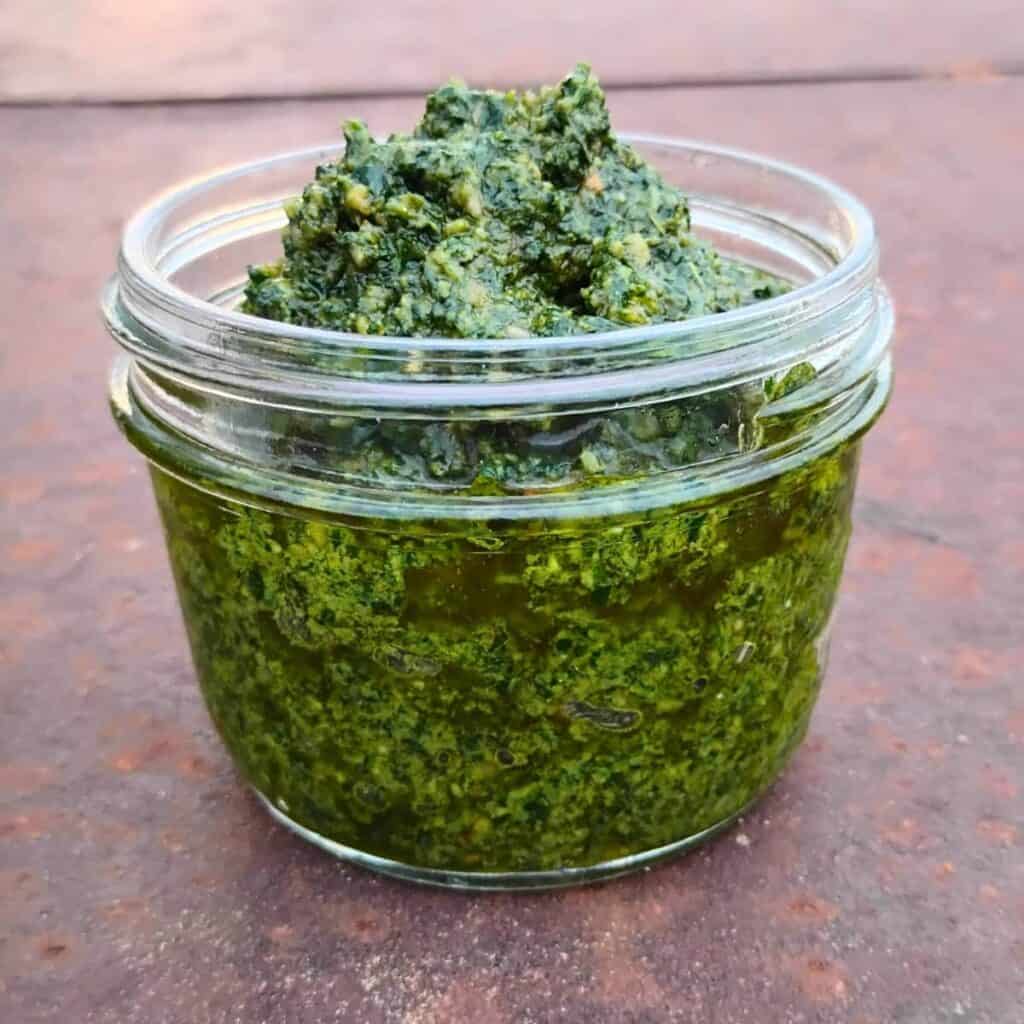
Here are some ways to include this healthy purple dead nettle into your diet. It has an earthy flavor, which I like quite a bit.
Make a dead nettle pesto! Just replace the basil with dead nettle or a mix of wild greens, like chickweed or lambsquarters. Delicious!
Use in omelettes, frittatas, quiches, or scrambled eggs.
Great when chopped and added to soups.
Use in mixed salads. The hairy leaves are not as appealing raw in my opinion, but if it’s mixed with other greens, it blends in pretty well.
Add to stir fries.
Make tea. You can take the tea for medicinal reasons, or just to enjoy a cup of herbal tea. However, too much of it might send you to the bathroom. It does act as a laxative, which is great when that is what you’re going for.
Blend up the leaves and flowering tops in smoothies.
Or try these Dead Nettle and Chickweed Fritters from the Herbal Academy. I haven’t made them, but it sounds delicious!
How to establish a patch of dead nettles
A word of warning is in place here: It likes to spread and if you leave it alone, it can easily take over a large area in your garden or lawn. But isn’t that what we want? I do. However, I get how that’s not everyone’s preference, and so by all means, if you want to establish it in your yard without it becoming invasive, keep harvesting it before it goes to seed and you might be able to contain it.
Dead Nettle thrives in moist, well draining soil. It will appreciate either partial shade with 6 hours or more of sun, or full sun. It is hardy in zones 6-9.
My dead nettle plant does not have purple leaves. Apparently this indicates that my soil is rich in phosphorus. Not a bad thing, I’d say, but it appears that phosphorus deficient soil brings a more purple hue to the plant’s leaves.
Here is how you can get yourself some dead nettle. It’s unlikely that you’ll find this plant in your nursery, but you can find it very often at the side of roads, in your friend’s garden, who likely wants you to take it all, because they consider it an obnoxious weed to rid themselves of.
Since this is an annual plant, it mostly propagates by seed. So if you know of a patch, collect some seeds in the summer, before they are dispersed. In early spring, you can also just dig up a plant and plant it in your yard so it can go to seed there and it will happily spread itself around.
How To Make A Purple Dead Nettle Tincture
And the best way to have easy access to the health benefits of purple dead nettles year round, is to make a tincture. This is very easy to do.
Ingredients:
1 quart of purple dead nettles, chopped. Note: If you have access to white dead nettles, feel free to use this same recipe. The benefits all seem to apply similarly to both.
750ml bottle of 50% (100 proof) vodka. If you cannot get 100 proof, you can use 80 proof. This is what I had when I made mine. It will be fine, but 100 proof is preferred for a balanced tincture. Where you want 50% alcohol and 50% water.
Optional: Glycerin or Vinegar instead of Alcohol. Alternatively you can use glycerin for a non-alcoholic tincture, or vinegar. Both, glycerin and vinegar will not keep as long. I recommend replacing them after a year. The alcohol based tincture will keep indefinitely. You can make your own vinegar for this too. Make the tincture as instructed, but replace all the alcohol with either glycerin (very sweet) or 5% vinegar.
Equipment:
Scissors or a knife for chopping
Two quart canning jars
Tight sealing lids my choice for a tight seal and less chance of corrosion is to place the flat part of a 2-piece canning jar lid on the canning jar and then use a screw on plastic lid to tighten it down. I find that it makes a tighter seal than using a metal band and it won’t corrode.
Here is another great option, that I just found out about and have not tried, but masontops is a brand I trust. You might want to give these plastic screwbands a try. I cannot find the plastic lids that I use on Amazon. The ones that Amazon sells all have those deep grooves inside where you put a seal. I don’t like them at all and they don’t work well with my method.
If you like the plastic lids I use, you can get them super reasonable at Walmart (no shipping option) in the canning isle. They come in wide mouth and regular sizes.
Nutmilk bag or flowersack towel for straining out the herbs
Medium size Bowl to catch the tincture
Small Dropper bottles for easy dosing.
Purple Dead Nettle Tincture Instructions
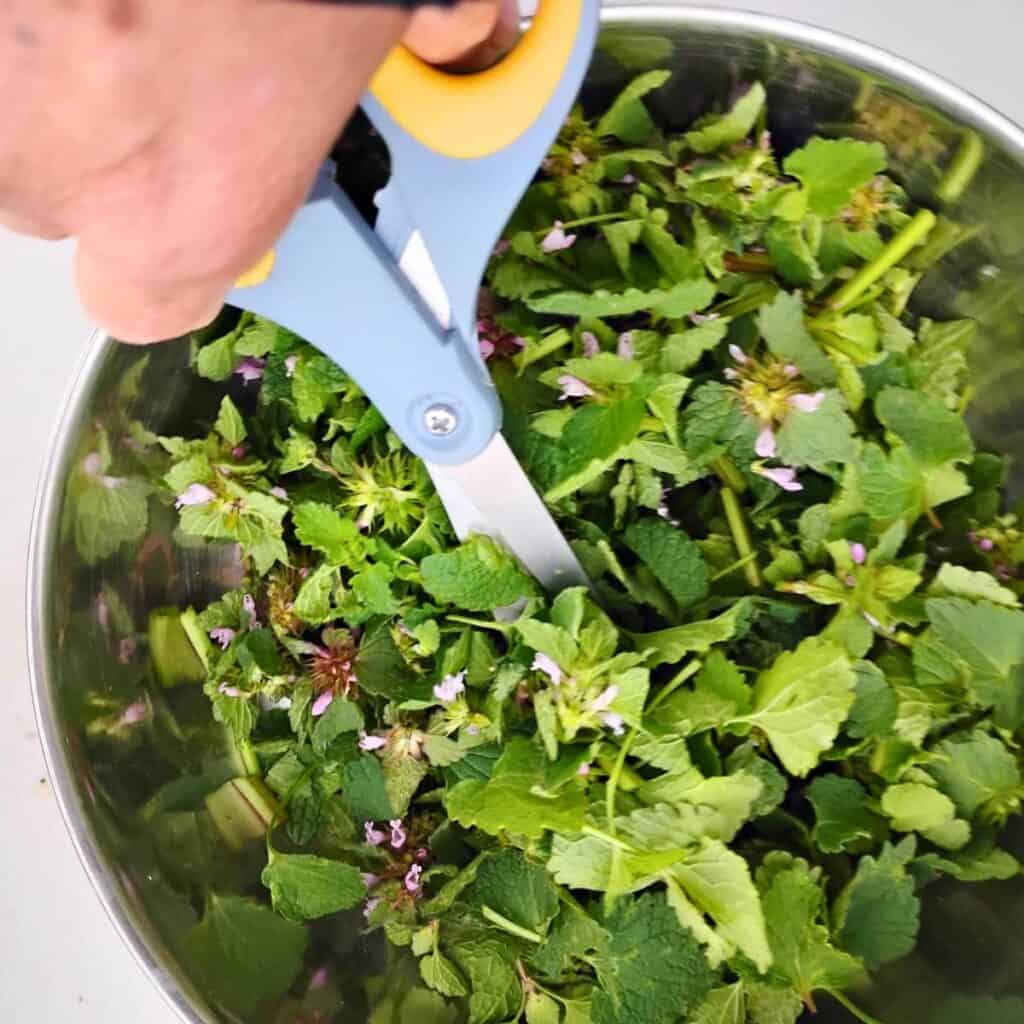
Roughly chop your dead nettles or use scissors to cut them into small pieces.
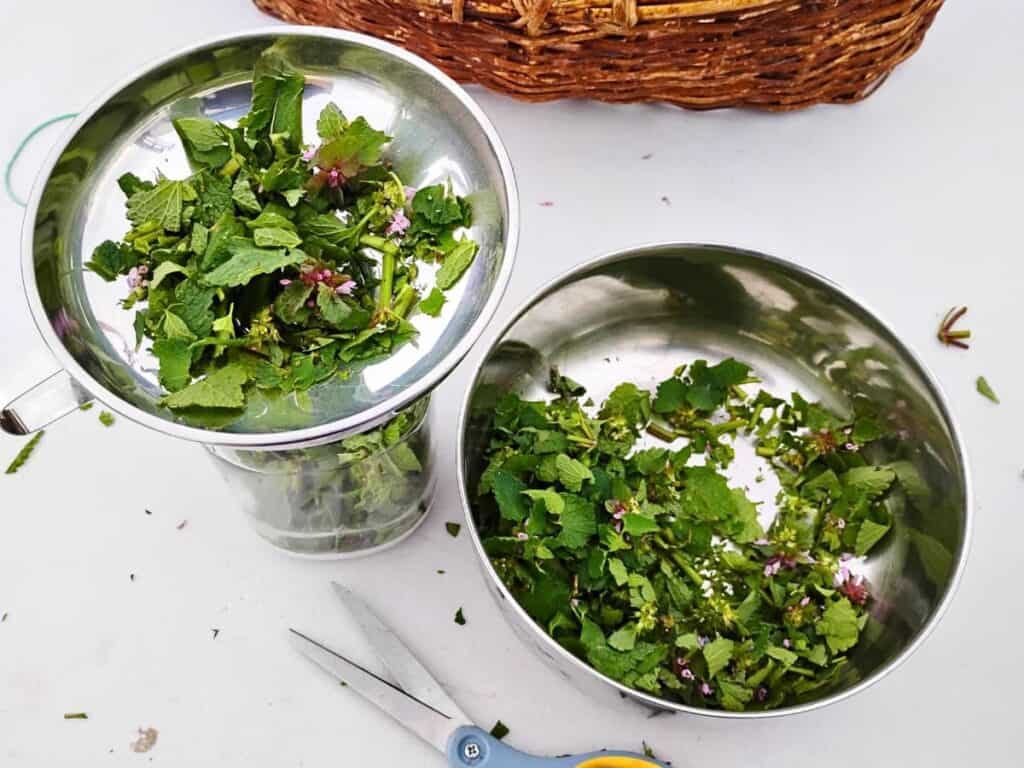
Place the herbs into one of the quart jars. Don’t pack them in too tight, just loosely fill the jar to the top.
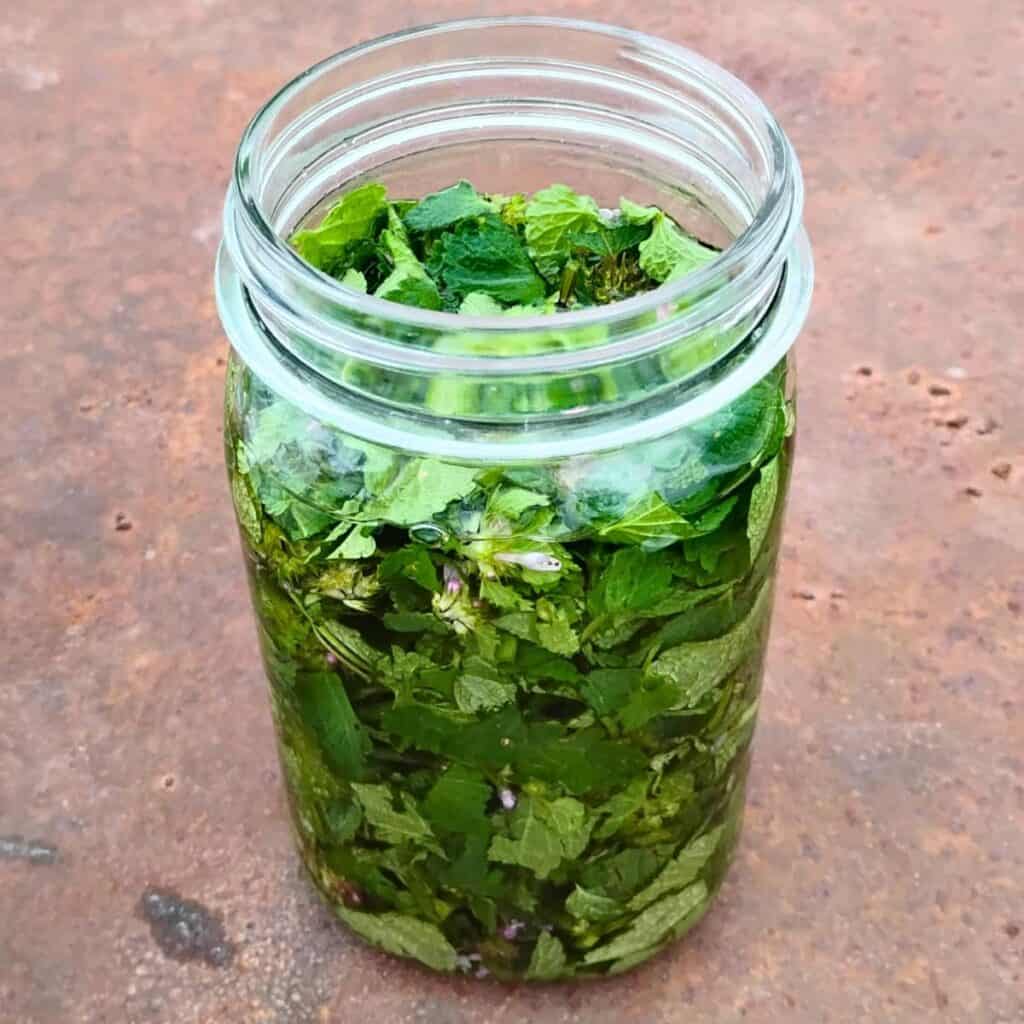
Add vodka to cover the herbs. Ideally fill the jar to the very top to reduce oxidation.
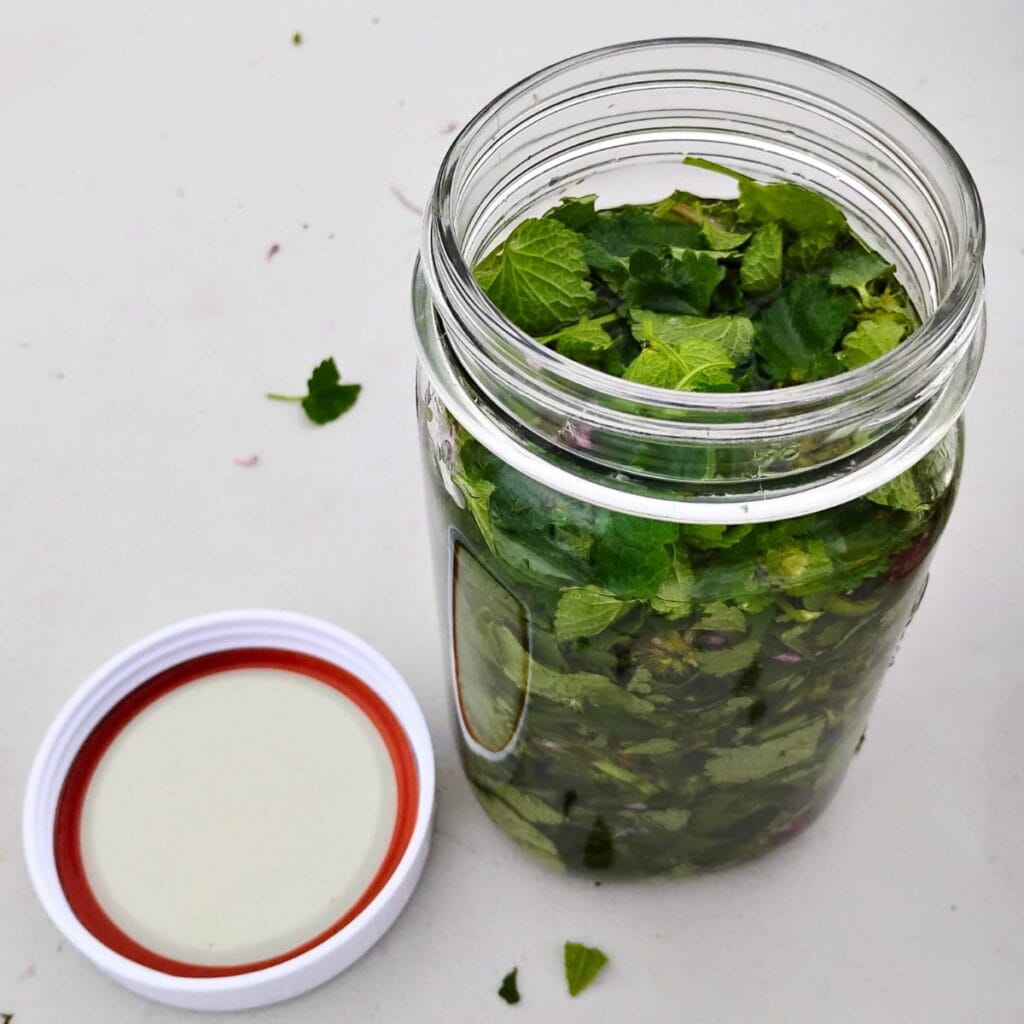
Seal the jar tightly with a lid.
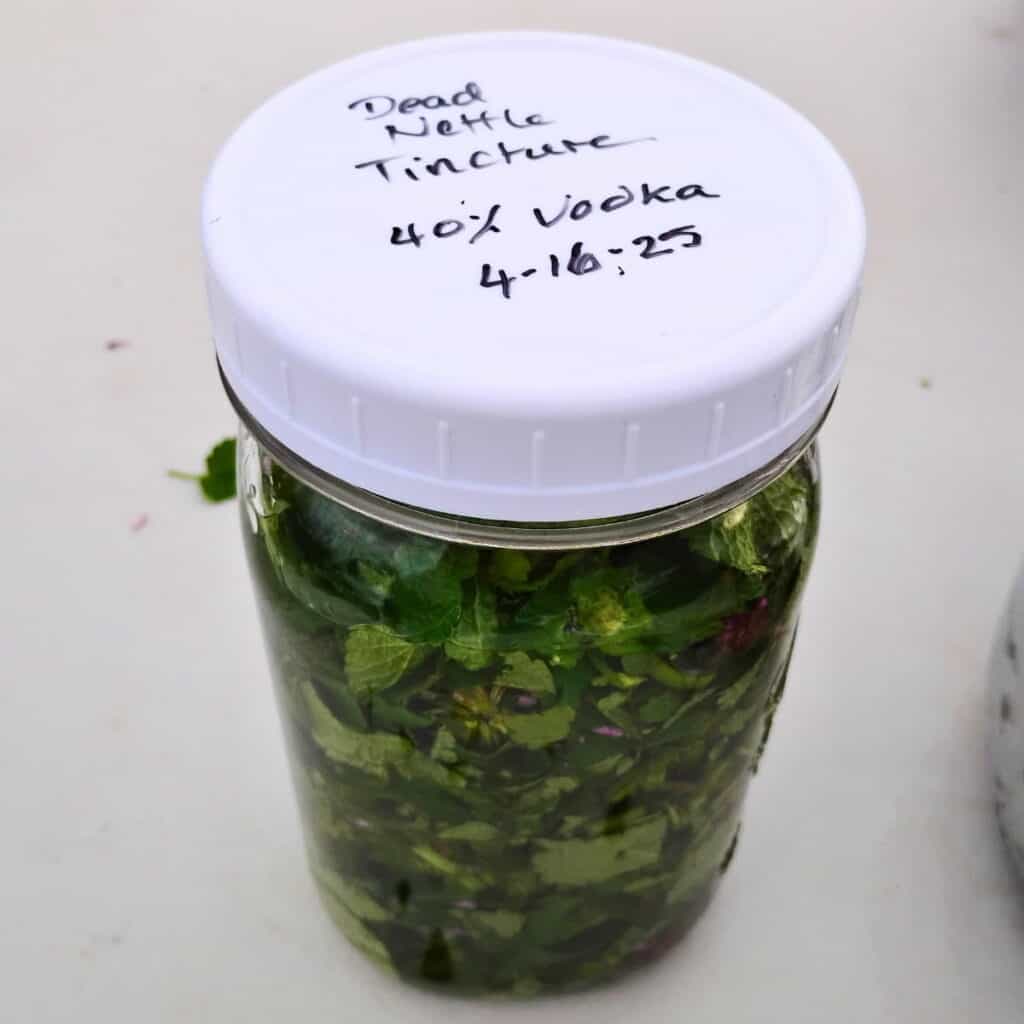
Shake it up a bit and place the jar in a corner out of sunlight, where it’s not in the way for a few weeks. If you remember, give it a shake every now and then, but that’s not essential.
Let it macerate (extract) for 6-8 weeks.
After this time you can strain the herbs out with a cloth or nut milk bag and catch the tincture in a bowl. Squeeze the bag to get as much of the tincture out of the plants as possible and feed the solids to your compost. (I’ll add photos when I’m ready to strain mine).
Storing your purple dead nettle tincture
Store the tincture in a tightly sealed Jar. Here too, I like to use a canning jar with a flat metal lid, covered with a plastic lid.
If you want to use the tincture, you might want to fill a small amount into a dropper bottle, which makes it easy to dose. However it is not ideal for long term storage. Those little rubber tops will allow the alcohol to evaporate over time and that will ruin your tincture. But it’s ok to keep it in the dropper bottles for a couple of months.
Dosage:
The generally recommended dosage size for most herbal tinctures for adult humans is 10-30 drops 3 times over the course of a day. One dropper contains 20 drops.
However, I recommend to start with micro-dosing, and only increase if necessary. Many herbs work beautifully even if you take just 2-3 drops at a time several times a day.
Your Questions Answered
How Long Will The Tincture Keep?
Your tincture will keep indefinitely if it’s well sealed and in a dark place. The two things that can ruin it are evaporation of the alcohol through a permeable lid or if you use a plastic bottle. The other enemy is light. So keep that in mind when storing your tinctures and they should be fine many years from now.
What Is Purple Dead Nettle Good For?
The purple dead nettle has many health benefits, such as powerful antioxidants, flavonoids, and terpenes that can act on numerous acute and chronic health complaints as well as offer prevention. But it can also be used as a nutritious vegetable. the whole plant is edible.
Is Purple Dead Nettle A Laxative?
Yes, one of it’s benefits is the relief of constipation and detoxification. It should be taken with care, in moderation, and introduced slowly to test its effects, especially if heading to the bathroom is not your goal.
Are You Ready To Give The Purple Dead Nettle A Try?
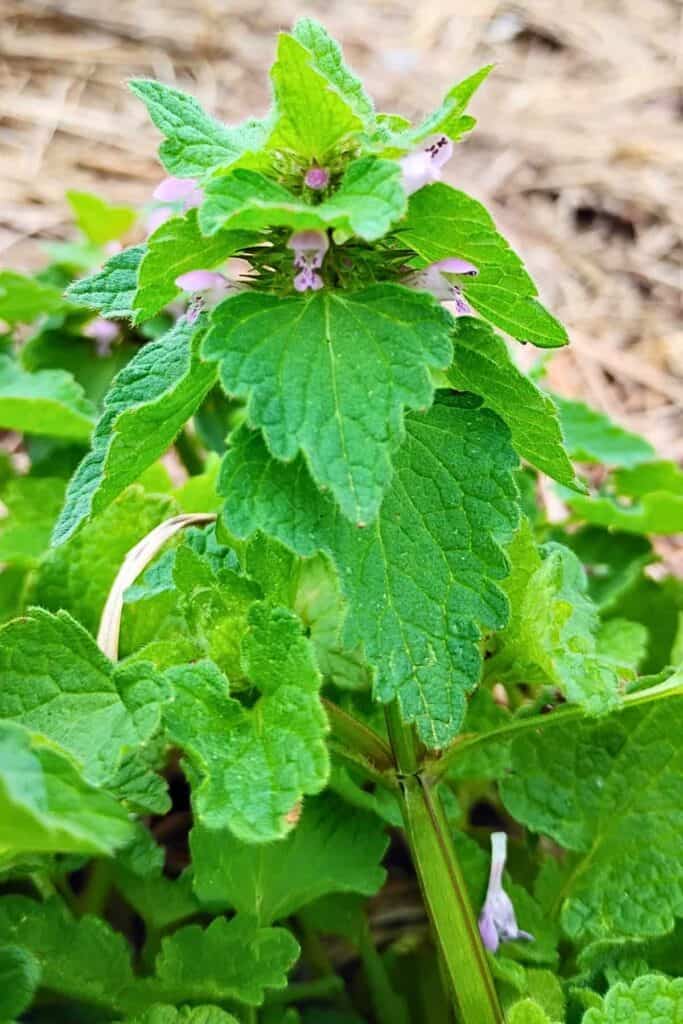
Considering how many people want to get rid of this wonderful herb, it would be a great way to reduce its presence by cooking it up as a vegetable and it would do a world of good for the person who eats it. Really, what could be better than making good use of an unwanted weed than turning it into a nutritious meal?
For medicinal use, making a tincture is the best way to capture all its health benefits for year round use.
Next time you’re looking at a patch of purple dead nettles, give them a try and you’ll not only have a great new vegetable that’s as nutritious as your carefully tended spinach, but it has so many extra health benefits too. And if you suffer from allergies, you might just find yourself feeling better by using this awesome little herb.
Let me know if you’ve tried purple dead nettle and how you use it! I’d love to hear your ideas for cooking with it! Don’t be shy to comment below and throw your question at me if there is something more you’d like to know.
To get more recipes like this and other information on homesteading and traditional skills, sign up for my Food For Life Garden News, and I’ll let you know when I post new information.
More Content Like This
Foraged Wild Weeds Pesto Recipe – Make a delicious Pesto with dead nettles and other wild weeds with this guide to foraging wild greens.
Make A Lemon Balm Salve – Benefits of lemon balm and how to make a salve for cold sores, bug repellant, bug bite relief and more.
Lemon Balm Tincture – Make a delightful tincture from fresh lemon balm. Learn about the benefits, uses and how to grow it too! This is an essential tincture to stock in your apothecary!
Turmeric Tincture Recipe – Make your own effective turmeric supplement, that is convenient to use and keep with you when you’re not home. A potent extract of the whole turmeric root.
Black Walnut Tincture – Black walnut has been used as a deworming tincture for a long time. Make your own with my recipe. I like to use it as part of my goat deworming routine with great results so far.
25 Essential Herbs To Plant – Start your home apothecary garden with these 25 powerful allies for your health. Learn their benefits, how to grow them and where to source them.
Homemade Apple Cider Vinegar – This lovely vinegar is made from apple scraps, not the actual apple cider. But it is just as effective, easier to make and uses all those leftover apple scraps or ugly apples.
Switchel Recipe – A refreshing electrolyte drink for hydration during summer activities.
Prepared and Fermented Horseradish – Make your own prepared horseradish with homemade vinegar or ferment it. Bonus recipe: horseradish tincture. Great for digestion and sinus infections.
Fire Cider Recipe – Get your fire cider recipe and make this tonic to be ready for cold and flu season!
Fermented Ginger Honey – Keep this potent fermented health food on hand. Use the powers of Ginger and Honey in a tasty syrup form that you’ll love.
Health benefits of ginger beer – Learn all about the awesomeness of ginger and its health benefits.
Purple Dead Nettle Tincture
Equipment
- Scissors or a knife – For chopping
- 2 quart canning jars
- 2 tight sealing lids
- Nut milk bag or flower sack towel – For straining out the herbs
- Medium size Bowl – To catch the tincture
- Small dropperbottles – For easy dosing
Ingredients
- 1 quart of purple dead nettle leaves – Note: If you have access to white dead nettles, feel free to use this same recipe and the benefits all seem to apply similarly to both.
- 750 ml bottle of 50% (100 proof) vodka – 80 proof will work in a pinch, but 100 proof is preferrable
Instructions
- Roughly chop your dead nettles or use scissors to cut them into small pieces.
- Place the herbs into one of the quart jars. Don't pack them in too tight, just loosely fill the jar to the top.
- Add vodka to cover the herbs. Ideally fill the jar to the very top to reduce oxidation.
- Seal the jar tightly
- Shake it up a bit and place the jar in a corner out of sunlight, where it’s not in the way for a few weeks. If you remember, give it a shake every now and then, but that’s not essential.
- Let it macerate (extract) for 6-8 weeks.
- After this time you can strain the herbs out with a cloth or nut milk bag and catch the tincture in a bowl. Squeeze the bag to get as much of the tincture out of the plants as possible and feed the solids to your compost.
- Store the tincture in a tightly sealed Jar. I like to use a canning jar with a flat metal lid, covered with a plastic lid, this makes a snug seal and it doesn't corrode like metal
- If you want to use the tincture, you'll want to fill a small amount into a dropper bottle, which makes it easy to dose. However, this is not ideal for long term storage. Those little rubber tops will allow the alcohol to evaporate over time and that will ruin your tincture. But it's ok to keep it in the dropper bottles for a couple of months.
Dosage:
- The generally recommended dosage size for most herbal tinctures for adult humans is 10-30 drops 3 times over the course of a day. One dropper contains 20 drops.
- However, I recommend to start with micro-dosing, and only increase if necessary. Many herbs work beautifully even if you take just 2-3 drops at a time several times a day.
Notes
Are You Ready To Give The Purple Dead Nettle A Try?
Considering how many people want to get rid of this wonderful herb, it would be a great way to reduce its presence by cooking it up as a vegetable and it would do a world of good for the person who eats it. Really, what could be better than making good use of an unwanted weed than turning it into a nutritious meal? And the tincture is the best way to capture all its health benefits for year round use.Pin This Post
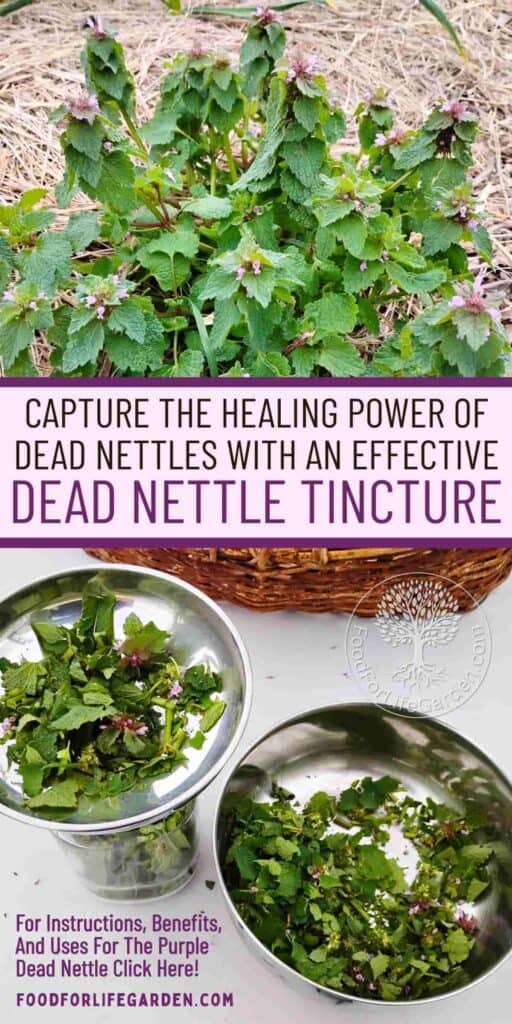
Shop This Post
Glycerin
Flour sack towels
Organic flour sack towels
Nut milk bag
Plastic screwbands
Dropper bottles
Butter muslin type cheesecloth

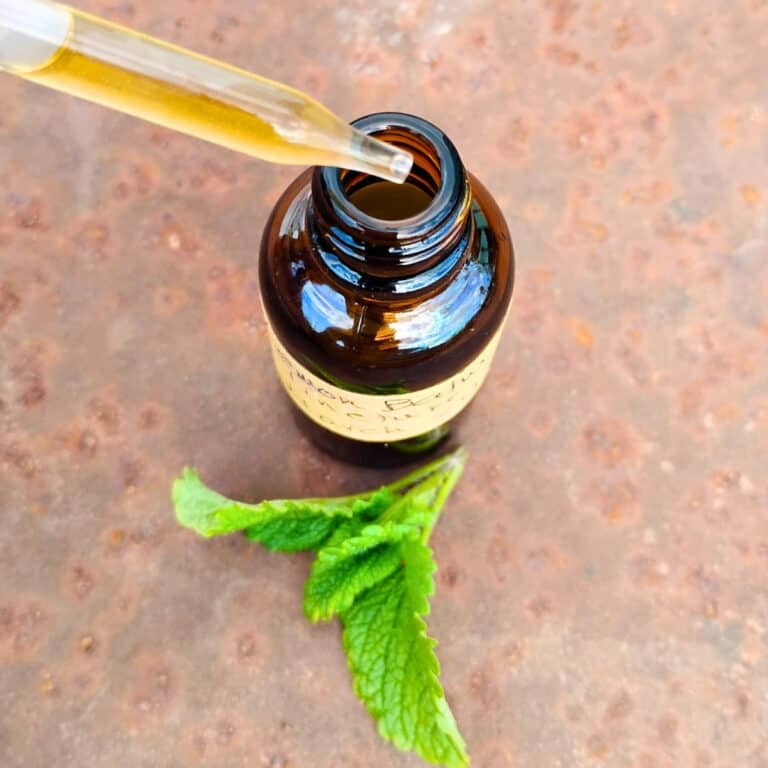
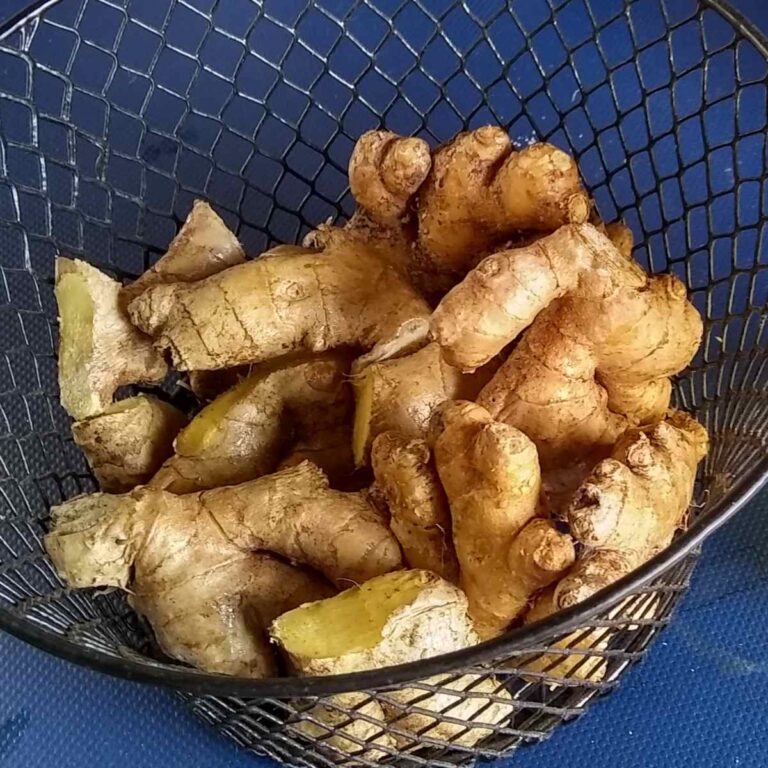
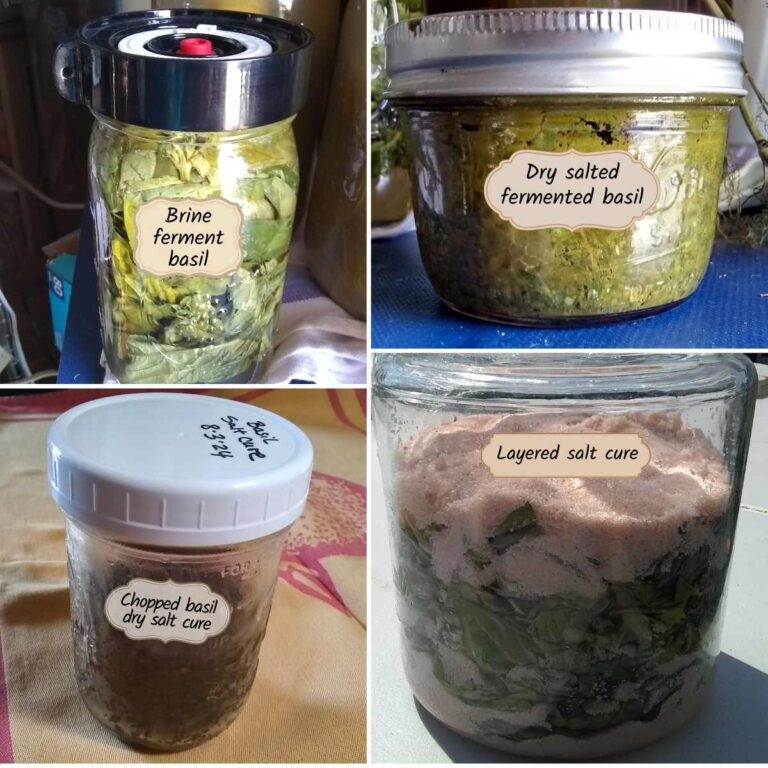
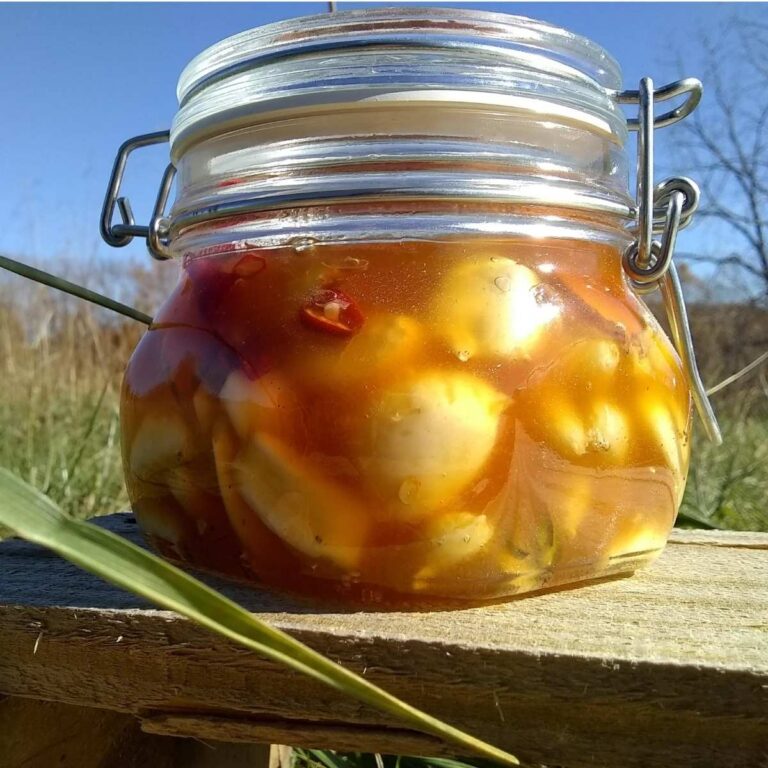
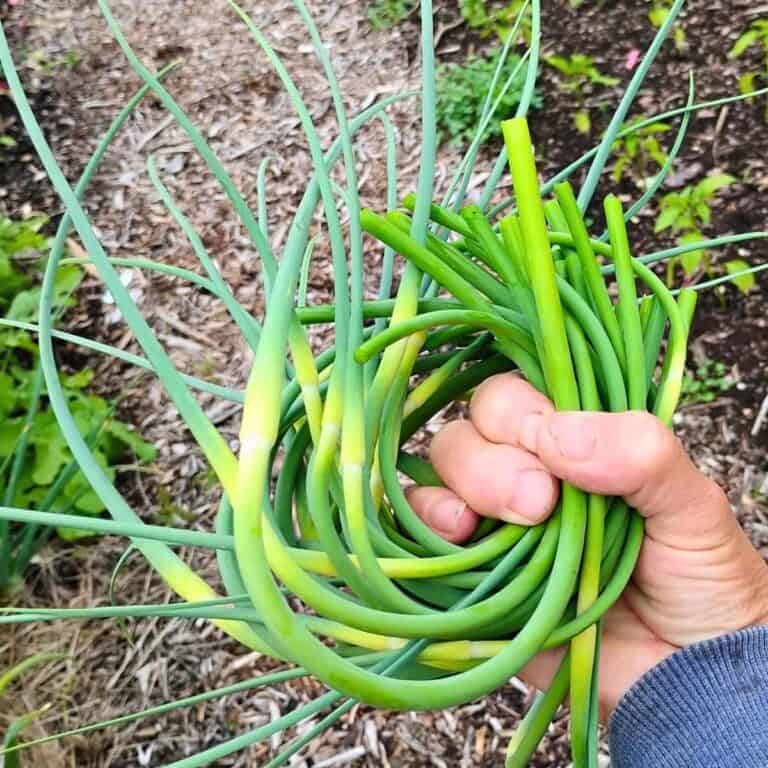
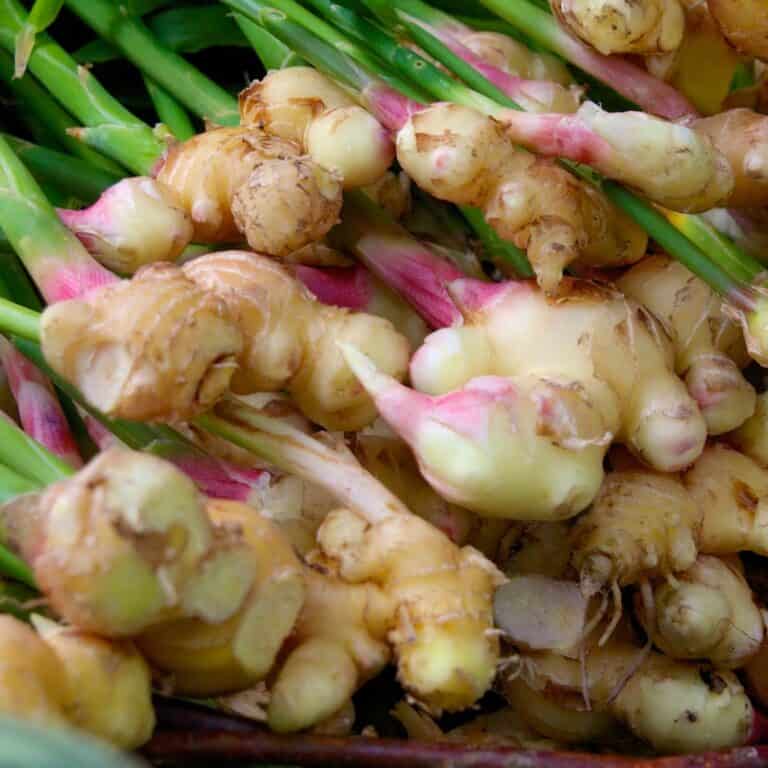
You’re so knowledgeable, I love learning through you!
Thank you so much for saying so. I sure appreciate it and I’m super thrilled if you found this helpful.
You have the coolest content. I learn something new with each of your posts! I didn’t even know this existed..I knew of the weeds that are prickly and me itch and I knew about the nettle leaf tea that I drank during pregnancy but now I have even more info! 🙂
That’s awesome! I’m so glad that you like this! And well, it’s hard not to know about those prickly weeds. I’ve got to battle tons of them here at my place. Seems like every other one has spikes and thornes.
Wow this article is super informative. I knew about regular nettles and being able to use them for teas and home made fertiziler but I hadn’t heard of purple dead nettles before now – I will be on the look out for them now.
Hey Jennifer, thank you so much for commenting! There are so many plants around me that I don’t even know the name of. I find it super fun exciting to find out what they are and how they can be useful. I hope you’ll find some dead nettles!
I drink nettle tea almost daily, but I want to try this!
Hey Sarah! That’s great! I love nettle tea and the stinging nettles are right on top of my favorite herbs list, but this dead nettle is really quite amazing too!
Awesome post! We have tons growing (like weeds😉) in our garden, and it has so many uses. I bet yours will take off in no time!
Haha, I think it might, I would love that. I heard that it can get quite invasive.
This is so interesting!! I remember my mom in Italy used to make risotto with stinging nettle, and add it to pesto and soups. Of course as a kid I didn’t appreciate it, but now it’s a different story: organic, nourishing food for free from weeds? A super big win! Thank you for sharing all your knowledge and this recipe. Now I need to find some purple dead nettle and try it! 🙂
Thank you so much for sharing this! That’s very cool your mom used stinging nettles a lot. I just got done writing a post about wild greens pesto and stinging nettles is one of the ingredients I mention there. They are really such great plants and so are the dead nettles.
We just moved to a new place. I haven’t seen PDN in over two years and I’m looking forward to searching around at the new property to see if I can find some. I didn’t realize all the benefits of this plant until reading your post!
I’m glad if you found this helpful. I wonder if there are places where they don’t grow! Maybe you’ll find some!
What a timing! I’m gonna have to read through this again later. We have a lot of those in the backyard!!
My husband was teaching my toddler the names of all the plants we have out there and sure enough! So many little things like this that people mow too early 🫣
That’s great, Ophelie! I know lots of people don’t like things growing other than grass, I was always opposite. Why grow grass, when you can grow other things, lol. I know I’m a bit nutty like that. But I think it’s great that you’re teaching your little one about the plants. I loved going on nature walks with my mom when she pointed out different plants and named them. It probably helped set me up for a lifelong love of wild plants.
Thank you for providing this tincture recipe with medicinal benefits from foraged purple dead nettle! We have so much of this in our back-40.
Hey Jenni! Well, it sounds like you’ll not run out of food to eat if times get tough 😉.
I have memories of nettle growing at my grandma’s home, and finding a recipe for nettle tincture gives me ideas of what to do with it when I come across it next. Thanks for sharing!!
You’re so welcome, Haley! I’m glad if you found this helpful!
First I love all your recipes. My question for allergies can I make my tinture using dry herbs.
Hey Vangie! Thanks for your comment. While you can make the tincture with dry herbs, it is normally best to make it with the fresh ones. Fresh herbs contain water soluble compounds that diminish or evaporate with drying. So this tincture would be more potent with fresh herbs. But you can definitely try it with the dried herb, and see if it helps. I’ve only made it with fresh herbs, but some use a tea with dried herbs and claim that it helps, so I’d think that it would. And while you wait for your tincture, you can try making some tea with your dried herbs too. Hope this helps and I hope you’ll love your tincture!